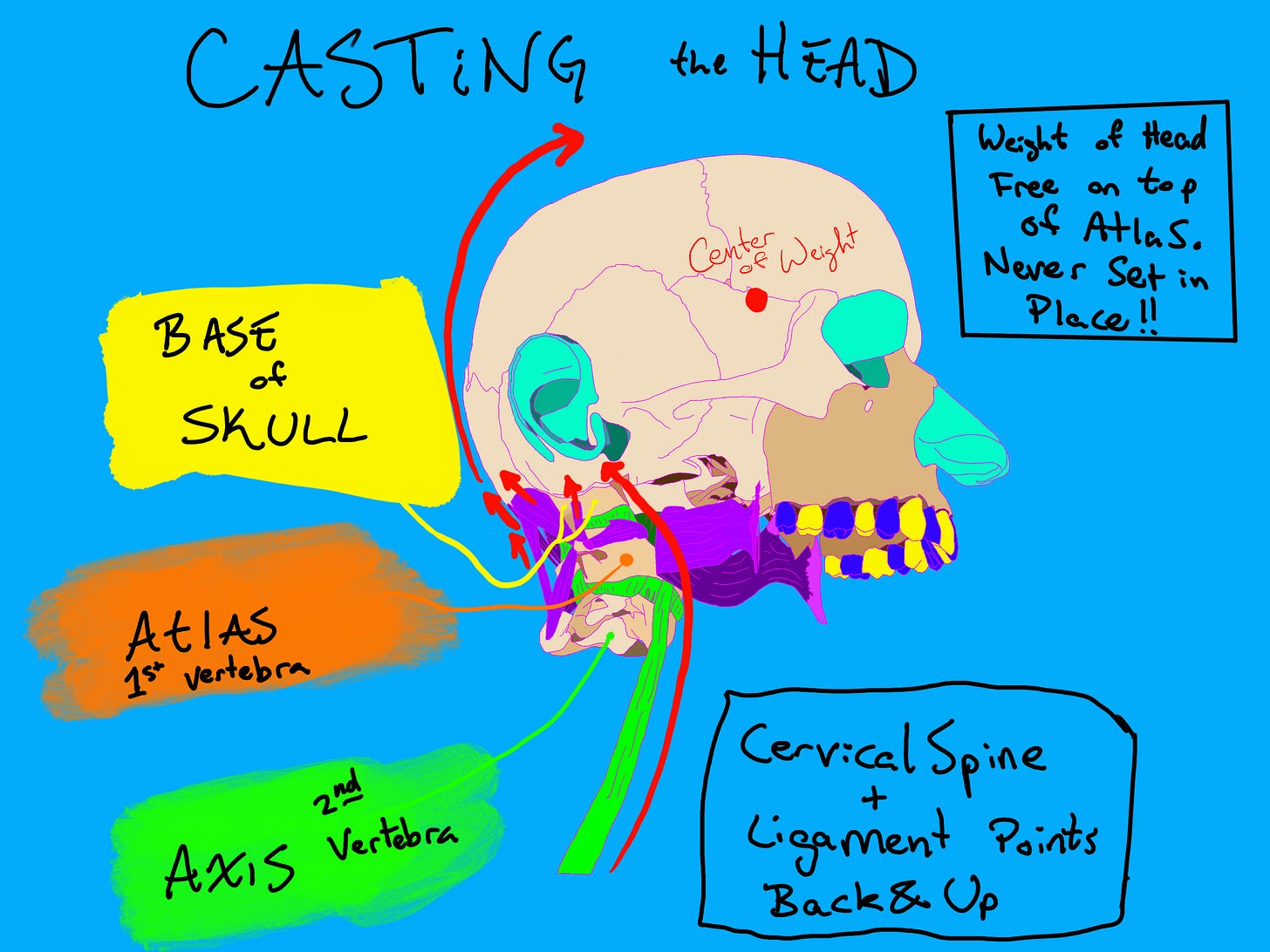Refining the Atlanto-Occipital Image
AKA The Top of the Voice
I’m back with the blogs this week! Apologies for missing you last week but I came down with a bit of flu. During that time, brain no work good but I did take the time to make more dumb drawings for you.
Why I’m Drawing the Head and Upper Neck… Again
A few weeks ago, I left you with this image of the head and upper neck. It shows a few of the muscles that connect the base of the skull to the 1st and 2nd vertebrae. What is particularly interesting to notice though is the shape of the top of the neck and how it relates to the back of the skull (red lines).
I’ve shared this with you because many of us have a habit of pressing the weight of the skull off-center. When this happens, the neck has a tendency to straighten out. We feel the muscles around the neck get tight, the jaw locks, we hold our breath, and it generally kicks off a super awesome fun time chain reaction down to the feet.
When you look at the drawing above, ask yourself how YOU feel. You probably cannot feel these red lines of dynamics flowing - I can only feel them flowing when things are quietly balancing. But you might be able to sense some of the purple muscles that I’ve highlighted. Let’s zoom in and check them out!
Enhance…
The big purple muscle on the right1 runs from the base of your skull to the far back portion of your face - just behind your teeth. It makes a U shape which you can better see in fig 1. You have several of these U shaped muscles running along the front of your spine that reach out to form a muscular support for the airway, food tube, and vocal apparatus.
You will feel this muscle constrict during the act of swallowing. If your head is pressing down on the spine, these U shaped muscles will just stay tight.
As you can see in figure 2, you have air that can come into your head via the nose (see the red/yellow bits). This air will brush along this muscle as you inhale. It’s a really nice exercise to quietly see if you can sense this inner space and imagine the U-shaped muscle as you inhale (all under the skull). You may begin to feel this space soften and come alive.
Removing Ligaments and Muscles
ENHANCE AGAIN!!!
If you look at the spine behind the U shaped muscle in fig 2, you’ll see ligaments and supporting/stabilizing muscles connecting the skull to the top of the spine. But let’s take a look underneath this and see how the bone of the skull meets the top of the spine.
This drawing shows a view of the skull, atlas, and axis from behind the right shoulder of the person. It is a slight rotation of the view in fig 2. Notice the two green lines.
At the base of the skull, you have 2 boney rockers2. These rockers sit on top of the grooves of the Atlas. This joint gives us the ability to pitch the head down/up.
Exercise: If you can feel the U-shaped muscle of your throat softening and expanding. Take a moment to allow the head to slowly pitch up and down. See if you can feel the skull moving and the muscles inside the throat being mushy and flexible.
Sensing the Voice
The exercise above is intended to give you a better sense of the internal space of the voice (at least the tippy top of the voice). I think this is an important area to learn to sense/feel. It is a critical juncture for a lot of basic functions that we need for living and is FM Alexander’s means of evaluating the use and functioning of the whole organism.
FM Alexander essentially used the health and functioning of the voice as a canary in the coal mine for evaluating his whole self. For a performing artist, the use of the voice is a critical part of doing one’s job. For the rest of us, it isn’t necessarily something that we think about…ever!
For many people with stiff necks/neck pain, they never complain about their voice. They will complain about all of the muscles along the back or base of the neck. It’s understandable given that that is where most of our sense of pain will go. But leaving out a sense of the vocal apparatus will perpetuate the tension in the neck… because… well.. your voice is a big part of your neck!
With that in mind, take a look at the figure below.
See the red zone called “the voice”? It’s pretty big when compared to everything else in the picture. Don’t think that it lives in isolation from the rest of your head and neck.
But before we go down the rabbit hole (or coal mine???) of exploring the whole vocal apparatus, see if you can feel that U-shaped muscle of the throat softly resonating while you hum. See if you can feel it slowly moving about as you swallow. And see if it feels taller and bigger than you initially thought. It will help you refine your sense of YOU!
Get In Touch
Have a question about this post? Ask in the comments below or hit the like button. You know, all those good social interaction things for the algos!
If you’re in NYC, you may learn more about my private teaching practice at johndalto.com.
If you’d like to book any lesson time with me, you can find my booking link here.
This muscle is called the superior pharyngeal constrictor.
Condylus Occipitalis.






